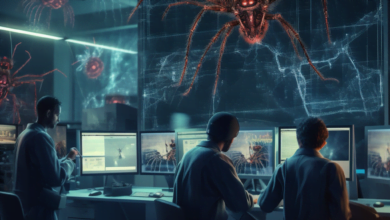Combatting Advanced Persistent Threats: Mastering Defense Against Stealthy Cyber Adversaries
Unveiling Effective Strategies Against Complex Cybersecurity Threats

In the ever-evolving landscape of cybersecurity, Advanced Persistent Threats (APTs) emerge as one of the most daunting challenges facing organizations today. Characterized by their stealth, persistence, and sophistication, APTs are not just ordinary cyber threats; they are highly coordinated attacks carried out by adversaries equipped with a vast array of resources and a deep understanding of cyber espionage and warfare tactics. These adversaries, ranging from nation-states to well-organized criminal groups, engage in elaborate campaigns aimed at infiltrating networks, remaining undetected for long periods, and achieving specific, often malicious, objectives.
The hallmark of an APT is its ability to use a blend of advanced techniques and technologies to breach defenses, making these threats particularly difficult to detect and neutralize. Unlike conventional cyber attacks that might seek immediate financial gain, APTs are methodical and goal-oriented, focusing on long-term infiltration and data exfiltration, disrupting critical operations, or laying the groundwork for future attacks. The targets of APTs are typically high-value entities in government, defense, finance, and critical infrastructure, where access to sensitive information or systems can yield significant strategic advantages.
With this introduction, let us set the stage for a deep dive into the world of Advanced Persistent Threats. We will explore the operational tactics of APTs, including their common methods of attack, such as spear-phishing, exploitation of software vulnerabilities, and lateral movement within compromised networks. Understanding the nature of these threats is the first step in developing effective strategies to counter them. As we proceed, we will outline a series of countermeasures designed to enhance organizational resilience against the sophisticated and stealthy maneuvers of APTs.
Dissecting the Operational Framework of APTs
Advanced Persistent Threats (APTs) are a sophisticated blend of tactics, techniques, and persistence, posing significant challenges to traditional cybersecurity defenses. Understanding the operational framework of APTs is crucial for developing effective strategies to counter these stealthy adversaries. This section explores the common targets of APTs, their preferred tactics and techniques, and the inherent challenges they present.
Common Targets of APTs:
APTs often aim at high-value targets that offer strategic, financial, or political gains. These include:
- Government Agencies: To extract sensitive national security information or disrupt governmental operations.
- Financial Institutions: To steal financial data or manipulate markets.
- Critical Infrastructure: Such as power grids or water treatment facilities, to cause public disruption or extract ransom.
- Healthcare and Research Institutions: To gain access to proprietary research or sensitive patient data.
Tactics and Techniques Employed by APTs:
- Spear-Phishing Campaigns: APT groups commonly use targeted spear-phishing emails to gain initial access to an organization’s network. These emails are meticulously crafted to appear legitimate, often impersonating trusted sources to trick recipients into disclosing credentials or downloading malicious attachments.
- Example: An email seemingly from the IT department asking employees to update their passwords, directing them to a fraudulent website where their credentials are harvested.
- Exploitation of Vulnerabilities: APTs exploit software vulnerabilities, especially those undisclosed to the public (zero-days), to gain unauthorized access or elevate privileges within a network.
- Example: Utilizing a zero-day vulnerability in a widely used software to deploy malware across an organization’s network undetected.
- Lateral Movement: Once inside a network, APTs employ lateral movement techniques to navigate across systems and access valuable data, often leveraging compromised credentials or exploiting internal vulnerabilities.
- Example: Using stolen administrative credentials to access secure data servers within a network, moving stealthily to avoid detection.
Challenges Posed by APTs to Traditional Cybersecurity Defenses:
- Stealth and Persistence: APTs are designed to evade detection for long periods, making them particularly challenging for traditional security measures that rely on known signatures or patterns.
- Highly Resourced and Skilled Adversaries: The entities behind APTs often have substantial resources and advanced technical skills, enabling them to develop and deploy sophisticated hacking tools and methodologies.
- Dynamic Tactics: APTs continually evolve their tactics and techniques, rendering static defense mechanisms ineffective over time.
Understanding the operational framework of APTs is the first step towards crafting a nuanced defense strategy capable of countering their advanced tactics. The complexity and sophistication of APTs require a dynamic and multi-layered approach to cybersecurity, one that goes beyond conventional defenses to protect against these stealthy and persistent threats. In the following sections, we will delve into specific countermeasures and best practices for defending against APTs, equipping organizations with the knowledge to safeguard their critical assets.
Countermeasures to Fortify Against APTs
In the battle against Advanced Persistent Threats (APTs), organizations must employ a multifaceted and proactive approach to defense. This section outlines critical countermeasures and strategies that can significantly enhance an organization’s resilience against these sophisticated cyber adversaries.
1. Exhaustive Network Monitoring:
Continuous and comprehensive monitoring of network activity is vital for early detection of APT-related anomalies.
- Implementation: Deploy advanced network monitoring solutions that utilize artificial intelligence and machine learning to detect subtle signs of compromise, such as unusual outbound data transfers or atypical login patterns.
- Example: An organization may notice an irregular spike in data traffic late at night, indicating potential exfiltration activities. Prompt investigation and response can mitigate the damage by isolating affected systems and analyzing the breach.
2. Regular Employee Awareness Training:
Since APTs often exploit human vulnerabilities through social engineering, regular employee training is crucial to raising awareness and reducing risk.
- Training Focus: Conduct sessions on recognizing spear-phishing attempts, secure password practices, and the importance of reporting suspicious activities.
- Example: Employees trained to scrutinize emails for signs of phishing (such as urgent requests for sensitive information or links to unfamiliar websites) can prevent initial access by APT actors.
3. Advanced Threat Detection and Response Systems:
Investing in advanced threat detection systems enables organizations to identify and respond to threats more effectively.
- Advanced Solutions: Implement solutions like Endpoint Detection and Response (EDR) and Security Information and Event Management (SIEM) systems that provide real-time analysis and automated response capabilities.
- Example: An EDR system could automatically quarantine a device showing signs of compromise, such as executing unauthorized commands or making suspicious network connections, thereby preventing further spread of the attack.
4. Segmentation of Access and Privileges:
Limiting access rights and segregating network segments can reduce the blast radius of an APT infiltration.
- Access Controls: Adopt the principle of least privilege, ensuring employees have only the access necessary for their roles.
- Example: Creating separate network zones for different departments or functions can prevent an attacker from easily moving laterally across the organization’s network after compromising a single endpoint.
5. Incident Response Planning:
Having a well-defined incident response plan ensures preparedness and swift action in the event of an APT detection.
- Response Strategy: Develop a plan outlining specific steps for containment, eradication, and recovery following a breach, along with clear communication protocols.
- Example: A detailed playbook that includes procedures for isolating affected systems, conducting forensic analysis to understand the breach, and communicating with stakeholders can significantly reduce the impact of an APT attack.
Defending against Advanced Persistent Threats requires a comprehensive, layered approach to cybersecurity. By implementing exhaustive network monitoring, conducting regular employee awareness training, deploying advanced threat detection systems, and adhering to best practices in access control and incident response, organizations can significantly bolster their defenses against the sophisticated tactics employed by APT actors. In the next section, we invite the BugBustersUnited community to share their experiences, insights, and strategies in combating APTs, fostering a collaborative defense against these complex threats.
Community Insights: Collaborative Defense Against APTs
The dynamic and sophisticated nature of Advanced Persistent Threats (APTs) requires not just individual organizational efforts but a collective response from the cybersecurity community. In this section, we invite members of the BugBustersUnited community to contribute their insights, experiences, and innovative strategies for combating APTs. Through shared knowledge and collaborative problem-solving, we can enhance our collective defense against these formidable adversaries.
1. Sharing Experiences:
We encourage you to share your encounters with APTs, detailing the challenges faced and the countermeasures that proved effective. Whether it’s a story of early detection, a successful mitigation of a potential breach, or lessons learned from an attack, your experiences can provide valuable real-world insights.
- Example: A cybersecurity analyst might recount an instance where irregular network traffic was traced to a compromised endpoint, leading to the discovery of an APT. The steps taken to isolate and investigate the breach can offer practical insights into effective incident response strategies.
2. Innovative Defense Strategies:
If you’ve developed or implemented unique strategies or tools to detect, prevent, or respond to APTs, sharing these innovations can inspire others and contribute to a stronger community defense.
- Example: Perhaps your organization has created a custom tool that uses machine learning to analyze behavioral patterns and detect anomalies indicative of APT activity. Describing this tool’s development and deployment could spark ideas and encourage adoption of similar technologies.
3. Collaborative Problem-Solving:
Encountering challenges in enhancing your defenses against APTs? Pose your questions to the BugBustersUnited community. Collaborative problem-solving can lead to innovative solutions, leveraging the collective expertise of cybersecurity professionals worldwide.
- Example: If you’re struggling with fine-tuning your SIEM system to balance between false positives and missing genuine threats, a query to the community can yield advice, configurations, and strategies from peers who have faced similar challenges.
The fight against Advanced Persistent Threats is ongoing and evolving, with new tactics and technologies emerging constantly. By fostering an environment of open communication, collaboration, and shared learning, the BugBustersUnited community can play a pivotal role in advancing our collective security posture against APTs. Your contributions, whether they be stories of triumph, innovative solutions, or collaborative inquiries, are invaluable to building a resilient defense against the sophisticated cyber threats of today and tomorrow.




